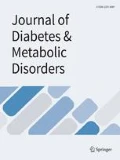Abstract
Background
The aim of the present study was to surveyed life style activity levels within diabetic patients attending the King Fahd teaching hospital of the University, Al-Khobar, Saudi Arabia, and studied their feeling towards performing different physical activity.
Methods
For this purpose, thirty Diabetic patients were randomly recruited, physically tested and handed a questionnaire to fill in.
Results
The result showed that the levels of physical activity are low and found an excessive use of cars by patients to go to public services and homes of friends and neighbors. Such unhealthy lifestyle habits encouraged patients to follow unhealthy habits such as disordered working patterns and infrequent social activity. While for those who follow healthy lifestyle pattern have better feeling while doing certain activities. For instance, patients who exercise running or jogging activities have better feeling while they rum. Moreover, patient who have healthier relaxing lifestyle pattern, have better feeling of what they do while they relax.
Conclusion
The use of exercise physiologists or physiotherapists and psychologists, education system is highly needed to explaining about the health benefits of physical activity. Physical activities should be promoted within the real context of the built environment in the eastern province, KSA.
Similar content being viewed by others
References
Brown MT, Bussell JK: Medication adherence: WHO cares? In Mayo Clin Proc. Elsevier; 2011: 304–314, 86.
Boule N, Haddad E, Kenny G, Wells G, Sigal R. Effects of exercise on glycemic control and body mass in type 2 diabetes mellitus: a meta-analysis of controlled clinical trials. Scand J Med Sci Sports. 2002;12:60–1.
Snowling NJ, Hopkins WG. Effects of different modes of exercise training on glucose control and risk factors for complications in type 2 diabetic patients a meta-analysis. Diabetes Care. 2006;29:2518–27.
Poothullil JM. Diabetes and decline in heart disease mortality. JAMA. 1999;282:1132–2.
Yates T, Haffner SM, Schulte PJ, Thomas L, Huffman KM, Bales CW, et al. Association between change in daily ambulatory activity and cardiovascular events in people with impaired glucose tolerance (NAVIGATOR trial): a cohort analysis. Lancet. 2014;383:1059–66.
Eyler AA, Brownson RC, Bacak SJ, Housemann RA. The epidemiology of walking for physical activity in the United States. Med Sci Sports Exerc. 2003;35:1529–36.
Hosler AS, Gallant MP, Riley-Jacome M, Rajulu DT. Relationship between objectively measured walkability and exercise walking among adults with diabetes. J Environ Public Health. 2014;2014:1–6.
Sallis JF, Saelens BE, Frank LD, Conway TL, Slymen DJ, Cain KL, et al. Neighborhood built environment and income: examining multiple health outcomes. Soc Sci Med. 2009;68:1285–93.
Dutton GR, Johnson J, Whitehead D, Bodenlos JS, Brantley PJ. Barriers to physical activity among predominantly low-income African-American patients with type 2 diabetes. Diabetes Care. 2005;28:1209–10.
Control CfD, Prevention: National diabetes fact sheet: national estimates and general information on diabetes and prediabetes in the United States, 2011. Atlanta, GA: US Department of Health and Human Services, Centers for Disease Control and Prevention 2011, 201.
Reddy MA, Zhang E, Natarajan R. Epigenetic mechanisms in diabetic complications and metabolic memory. Diabetologia. 2015;58:443–55.
Saleh F, Mumu SJ, Ara F, Hafez MA, Ali L. Non-adherence to self-care practices & medication and health related quality of life among patients with type 2 diabetes: a cross-sectional study. BMC Public Health. 2014;14(1).
Morrison Z, Douglas A, Bhopal R, Sheikh A, Forbes JF, Gill JM, et al. Understanding experiences of participating in a weight loss lifestyle intervention trial: a qualitative evaluation of south Asians at high risk of diabetes. BMJ Open. 2014;4:e004736.
Karimi Moonaghi H, Namdar Areshtanab H, Jouybari L. The efficacy of optimism: benefit finding in the treatment of diabetes in Iranian patients. ISRN Nurs. 2014;2014.
Yacoub TG. Combining clinical judgment with guidelines for the Management of Type 2 diabetes: overall standards of comprehensive care. Postgrad Med. 2014;126:85–94.
Thomas N, Alder E, Leese G. Barriers to physical activity in patients with diabetes. Postgrad Med J. 2004;80:287–91.
Korkiakangas EE, Alahuhta MA, Laitinen JH. Barriers to regular exercise among adults at high risk or diagnosed with type 2 diabetes: a systematic review. Health Promot Int. 2009:dap031.
Al-Saeed WY, Al-Dawood KM, Bukhari IA, Bahnassy A. Prevalence and socioeconomic risk factors of obesity among urban female students in Al-Khobar city, eastern Saudi Arabia, 2003. Obes Rev. 2007;8:93–9.
Raynor DT: Medication literacy is a 2-way street. In Mayo Clin Proc Elsevier; 2008: 520–522, 83.
Haynes RB, McDonald HP, Garg AX. Helping patients follow prescribed treatment: clinical applications. JAMA. 2002;288:2880–3.
Ryan AA. Medication compliance and older people: a review of the literature. Int J Nurs Stud. 1999;36:153–62.
Kalyango JN, Owino E, Nambuya AP. Non-adherence to diabetes treatment at Mulago Hospital in Uganda: prevalence and associated factors. Afr Health Sci. 2008;8.
Izard CE. Emotion theory and research: highlights, unanswered questions, and emerging issues. Annu Rev Psychol. 2009;60(1):1–25.
Chew B-H, Shariff-Ghazali S, Fernandez A. Psychological aspects of diabetes care: effecting behavioral change in patients. World J Diabetes. 2014;5:796.
Bener A, Ghuloum S, Al-Hamaq A, Dafeeah EE. Association between psychological distress and gastrointestinal symptoms in diabetes mellitus. World J Diabetes. 2012;3:123–9.
Damasio AR: The feeling of what happens: body and emotion in the making of consciousness. Houghton Mifflin Harcourt; 1999.
Goldstein MG, Whitlock EP, DePue J, Project PCotAMBRFiPC. Multiple behavioral risk factor interventions in primary care: summary of research evidence. Am J Prev Med. 2004;27:61–79.
Peterson JC, Charlson ME, Hoffman Z, Wells MT, Wong S-C, Hollenberg JP, et al. A randomized controlled trial of positive-affect induction to promote physical activity after percutaneous coronary intervention. Arch Intern Med. 2012;172:329–36.
Author information
Authors and Affiliations
Corresponding author
Ethics declarations
Conflict of interest
The author declared no potential conflicts of interest.
Additional information
Publisher’s note
Springer Nature remains neutral with regard to jurisdictional claims in published maps and institutional affiliations.
Rights and permissions
About this article
Cite this article
Al-Hariri, M. Life style activities and feeling state responses in community sample of diabetic patients in Eastern Providence Saudi Arabia. J Diabetes Metab Disord 18, 301–305 (2019). https://doi.org/10.1007/s40200-019-00413-2
Received:
Accepted:
Published:
Issue Date:
DOI: https://doi.org/10.1007/s40200-019-00413-2



